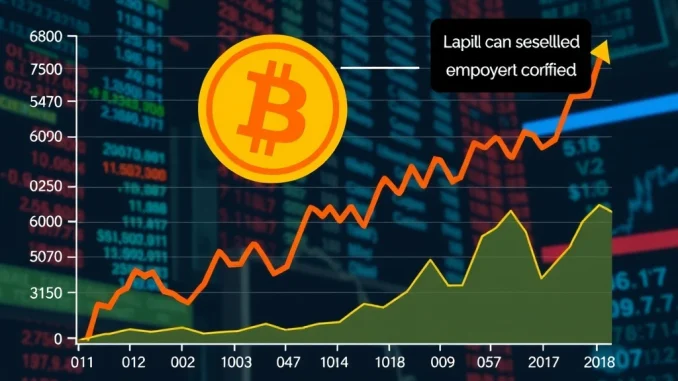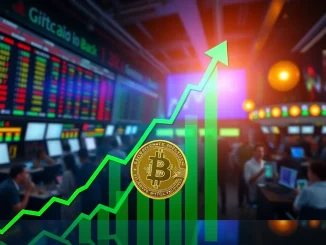
Is Bitcoin flashing a warning sign despite the positive headlines? While capital continues to flow into the crypto king, on-chain analytics firm Glassnode’s latest report suggests a deeper, more cautious sentiment is taking hold. Let’s dive into Glassnode’s analysis and decode what this risk-off sentiment could mean for Bitcoin and the broader crypto market.
Bitcoin’s Realized Cap Hits Record High, But Growth Slows
Bitcoin’s realized cap, a metric considered by many to be a more accurate reflection of Bitcoin’s market value than market capitalization, has reached an all-time high of $872 billion. This is undoubtedly a positive signal, indicating significant capital accumulation in Bitcoin. However, digging deeper into the numbers reveals a nuanced picture.
According to Glassnode, the monthly growth rate of Bitcoin’s realized cap has slowed to just 0.9%. While still positive, this deceleration suggests that the pace of new investment is not keeping up with previous trends. This slowdown could be an early indicator of a shift in investor behavior, hinting at a more cautious approach.

Decoding the Risk-Off Sentiment: What Does It Mean?
The term “risk-off sentiment” in financial markets describes an environment where investors become less willing to take on risk. This often leads to a shift away from assets perceived as riskier, such as cryptocurrencies and growth stocks, towards safer havens like government bonds or cash.
Glassnode’s analysis suggests that despite the continued capital inflows into Bitcoin, the underlying sentiment is trending towards risk-off. This apparent contradiction – money flowing in, but enthusiasm waning – is a crucial point to understand. It indicates that while some investors are still allocating capital to Bitcoin, perhaps for long-term holdings or strategic diversification, the broader market may be exhibiting caution due to macroeconomic uncertainties or other factors.
Factors Contributing to Risk-Off Sentiment:
- Macroeconomic Uncertainty: Global economic conditions, inflation concerns, and geopolitical risks can all contribute to a risk-off environment.
- Interest Rate Hikes: Rising interest rates can make riskier assets like cryptocurrencies less attractive compared to fixed-income investments.
- Regulatory Scrutiny: Increased regulatory attention on the crypto industry can also dampen investor enthusiasm and lead to a more cautious approach.
- Market Consolidation Signals: As indicated by Glassnode’s analysis, on-chain metrics themselves can signal potential market consolidation, leading to investor hesitancy.
Volatility-Adjusted Metrics Point to Market Consolidation
To further understand the current market dynamics, Glassnode examined Bitcoin’s realized gains and losses, adjusted for volatility. This volatility-adjusted perspective provides a clearer picture by normalizing the data against market fluctuations.
Their findings reveal that Bitcoin’s realized gains and losses have reached a near equilibrium recently. This balance suggests a period of market consolidation, where neither bullish nor bearish forces are decisively dominant. In such phases, price movements can become less directional and more range-bound, as the market seeks a new equilibrium.
Furthermore, the volatility-adjusted net profit/loss metric has returned to its long-term median. This is a significant observation because, historically, this median level has acted as a turning point between bull and bear market cycles. This doesn’t definitively predict an immediate shift to a bear market, but it does highlight a crucial juncture where market direction could become more volatile and uncertain.
Key Takeaways and Actionable Insights for Investors
So, what are the key takeaways from Glassnode’s analysis, and what actionable insights can investors glean from this?
Key Takeaways:
- Slowing Realized Cap Growth: While Bitcoin’s realized cap is at a record high, the slowing monthly growth rate suggests a decrease in the pace of new investment.
- Dominant Risk-Off Sentiment: Despite positive capital inflows, underlying investor sentiment appears to be risk-averse, potentially driven by macroeconomic factors.
- Market Consolidation Phase: Volatility-adjusted metrics indicate a market consolidation phase, with balanced realized gains and losses.
- Historical Turning Point: The volatility-adjusted net profit/loss metric returning to its long-term median suggests a potentially significant juncture in the market cycle.
Actionable Insights:
- Exercise Caution: The risk-off sentiment and consolidation signals suggest that a cautious approach to the Bitcoin market is warranted. Avoid impulsive decisions and prioritize risk management.
- Monitor On-Chain Metrics: Pay attention to on-chain metrics like realized cap growth and volatility-adjusted net profit/loss to gauge market sentiment and potential shifts in trends.
- Stay Informed About Macroeconomics: Keep abreast of macroeconomic developments, interest rate policies, and geopolitical events, as these factors can significantly influence crypto market sentiment.
- Prepare for Volatility: Consolidation phases can often precede periods of increased volatility. Be prepared for potential price swings and adjust your portfolio strategy accordingly.
- Long-Term Perspective: While short-term uncertainties exist, maintain a long-term perspective on Bitcoin and its potential. Market consolidations are a natural part of market cycles and can provide opportunities for strategic accumulation.
Conclusion: Navigating Bitcoin’s Cautious Crossroads
Glassnode’s analysis provides a valuable insight into the current Bitcoin market landscape. While record realized cap levels and continued capital inflows paint a seemingly bullish picture, the underlying risk-off sentiment and signs of market consolidation cannot be ignored. The market appears to be at a crossroads, and understanding these nuanced signals is crucial for navigating the path ahead. By exercising caution, staying informed, and maintaining a long-term perspective, investors can better position themselves to capitalize on opportunities while mitigating potential risks in this evolving market.



